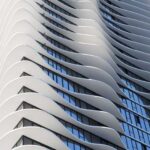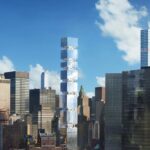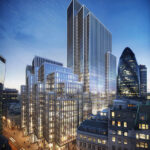Skyscraper Building Design Theory, Tall Buildings around the World, CTBUH Review
Skyscraper Building Design
Tower Architecture – article for e-architect by Nigel Henbury
24 January 2012
Skyscraper Buildings
Celebrity and the City
This week, two tendencies of the human desire to create buildings. They could not be further apart.
A review by CTBUH of the recent and continuing trend to build tall and tall(er) buildings sees Taipei included – the city that also accommodates CICADA Urban Acupuncture (Bamboo City) by Casagrande Laboratory (C-Lab).
The fact that these polar opposites are encouraged to coexist brings to mind the looming societal problems of ‘developed countries’, and a concern that emerging nations do not fall into the same trap as particularly the US and parts of Continental Europe are seemingly about to enter, and that which the great urbanisations of the southern hemisphere have struggled for decades to free themselves.
Are these two building types anything other than headlining extreme expressions of insular tendencies?
Are they expressions of art, architecture or engineering or an eclectic dedication?
The skyscraper – city maker, with historical benchmarks achieved in the likes of Chicago, New York, Tokyo, Hong Kong, Shanghai, Dubai.
World Skyscraper Building Design
Tallest skyscraper building completed in 2011
KK100 Tower, Shenzhen, China
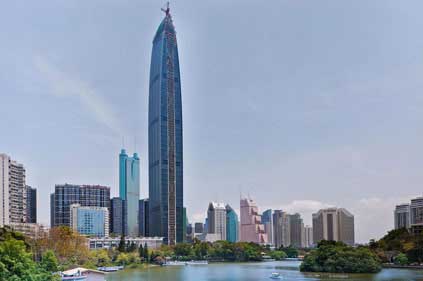
photo from TFP Farrells
Bamboo City – an addition to the C-Lab project portfolio of ‘sust –eco’ build to create a sensory and existential oasis in a highly urbanised location.
CICADA – Urban Acupuncture, Taiwan
Casagrande Laboratory
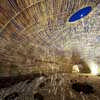
picture : AdDa
In early 20th Century US a freedom of the human condition to be able to leave the safety and security of terra firma was made possible by the architects and engineers of the time. Then truly a race between affluent world cities to reach for the sky in a rapid development of new materials in sub structure, super structure and cladding – simultaneously in building services, air handling and vertical transport.
A cutting edge city’s can-do, icon. Positive feats of engineering.
Initially proud head quarter buildings, undoubtedly brash, insular, unable to mesh with the fabric of the old world inner city. By necessity these solemn, self conscious statues needed kindred structures nearby for companionship and justification. The modern Central business district was born.
Domination of the skyline quickly achieved, majesty of scale questionable, humbling nearby ‘vertically challenged blocks’ and neighbourhoods, constructs of iconic landmarks and waterfronts created visually. Streets and sidewalks catch rays when they can.
As an international building type the skyscraper is assured – its iconic future likely to endure as attractive projects for investors and patrons of emerging cities in countries developing at relative speeds, apparently under the same economic model as their ‘developed peers’.
The skyscraper has evolved into a building art form of plastic possibilities as pacific rim centres of commerce vie for the tallest buildings only to be topped by Burj Khalifa in the challenging environmental climate and setting of Dubai.
Tallest skyscraper building in the world – Burj Khalifa skyscraper
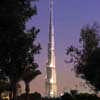
photo © Adrian Smith + Gordon Gill Architecture
This in turn will be topped with the realisation of the Kingdom Tower in Jeddah.
To be the World’s tallest skyscraper building
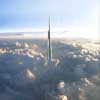
image © Adrian Smith + Gordon Gill Architecture
The technology of these buildings is unquestioned, but as for the philosophy of reaching higher to what will be the limit of the specified materials’ integrity, the ultimate was formerly achieved in the Pyramids and then across Europe by the stone masons at the zenith of the Gothic celebration of structure, aesthete and decoration in the continent’s greatest Cathedrals.
Technology and craft aside, one building type has celebrated, contemplated, worshipped The Almighty for hundreds of years the other celebrates…celebrity itself.
Sustained dedicated developments of possibilities in structure, cladding and services imbue ‘super model’ qualities to ‘elite’ design concepts in the new world cities. However it can be argued that purely to use this technology to build taller will end in folly and no longer useful to the greater human condition.
There could also be an argument that at a given threshold, a skyscraper becomes a pure engineering project and that a simple shelter is also conceived as such. C-Lab’s projects are no ‘shrinking violets’. They are bold commentaries on the modern massive, right in its face and pricking its conscience.
Both typologies ‘engineer’ our behaviour, the skyscraper is a selective filter and a conditioner of behaviour, de-humanising in some ways. The Bamboo City is planned to facilitate many facets of human behaviour. It is a contemporary icon of the extreme manifestations in the unacceptable and frustratingly continuing end game of inequality within nations’ societies.
We may be collectively looking at our destiny as a species In consideration of the development of modern Japan, whereby technological and economic innovation (debt management included) can reach only as far as social cohesion will allow it to be sustainable. Japan has led the developed world since the late 1960’s and is a class apart in managing the ultimately organic coexistence between humans and machines. However the country draws criticism from other ‘developed nations’ for allowing growth to be capped.
Where to go from here? It’s a generational dynamic and the next generation has to buy into the social cohesion Japan apparently possesses.
Emerging countries and cities should have the right to enjoy their time, but decision makers and potential patrons have a responsibility to stay true to their cultural heritage and realise that the path they take into a new dawn has been well trodden, badly eroded in places, and the parameters for any final destination unknown. Perhaps there lies the true definition of sustainability in that it will slow the human species from reaching ‘a final destination’.
City leaders must recognise through their choice of master-planners and designers that investment in connected social programmes of education, housing, health, employment, sustainable economies, culture and recreation will always give a city greater sustained esteem than even the tallest building.
Humans need to have their feet on the ground.
Nigel Henbury, 22 Jan 2012
Nigel Henbury is a Diploma Graduate of Portsmouth School of Architecture, England, golf course architect and Licentiate Member of the Landscape Institute, UK
Comments on this Skyscraper Building Design article are welcome.
Location: 8 Spruce Street, New York City, NY, USA
Skyscraper Designs
Al Hamra Firdous Tower, Kuwait City
SOM Architects
New York by Gehry
Frank Gehry
Infinity Tower Dubai
Skidmore Owings & Merrill
Wuhan Greenland Center, China
Adrian Smith + Gordon Gill Architecture
Comments / photos for the Skyscraper Building Design – Tall Buildings page welcome

